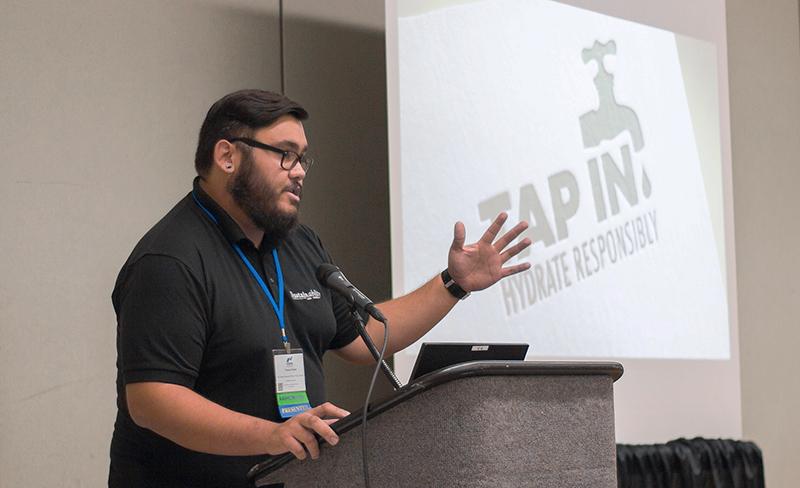Professor Steven Abraham of the marketing and management department published an article titled “Investors Expectations regarding the Railway Labor Act” in the Journal of Transportation Law, Logistics and Policy.
Jamie Adams, the college’s sustainability coordinator, and Thomas Pickett, a master’s student in graphic design and digital media who works with the Sustainability Office, presented at the Association for the Advancement of Sustainability in Higher Education Conference Oct. 9 to 12 in Baltimore. Adams presented “WTF? Waste, Technology and Facebook; Affecting Student Behavioral Change Through the Use of Technology and Social Media” on the positive outcomes and lessons learned in using technology and social media through the Tap In refillable water bottles campaign. Pickett (pictured), who also has a bachelor of fine arts from Oswego, was part of a panel presentation called “The Earth Without Art is Eh,” where he detailed his use of design and design thinking in launching the Tap In campaign on campus last spring semester.
Biological sciences faculty member Jinyan Guo took advantage of the college’s Early Start Program, which encourages new-faculty research the summer before their first classes start, to apply for and earn a grant of $11,908 from the American Iris Society Foundation for a study titled “Comparative Micro-Morphology, Anatomy and Development of Styles in Iris.” Guo, whose doctorate in botany is from Claremont Graduate University, will use SUNY Oswego equipment such as the scanning electron microscope and the light microscopy facility to study two closely related species of iris, a “showy and extraordinary flower,” according to her proposal. The research in 2017 and 2018 would employ and train students, and could lead to development of transgenic crops with styles—a flower structure that connects the stigma and the ovary—that look like the petal of a flower, have an increased area for pollen reception and increased efficiency with pollination.
Computer science professor Damian Schofield published “The Use of Computer Generated Imagery in Legal Proceedings” in the journal Digital Evidence and Electronic Signature Law Review. In the publication, Schofield describes research to assess the effect of computer-generated imagery on jurors, and some of the issues raised by the results. His paper concludes by discussing potential benefits and problems of implementing this technology in court settings.
Barbara Faye Streets of the counseling and psychological services department presented at two international conferences in August. At the American Psychological Association 2016 International Conference in Colorado, she presented at a symposium titled “World Refugee Trauma – Women, Children, Families and Social Justice.” The topic of her presentation was “Expert Helpers in Haiti: Competencies with Women, Children and Families.” Streets also presented at the Association of Black Psychologists 48th annual International Convention in Arlington, Virginia. The title of her poster was “The Faculty Success Program: An Inclusive Online Environment That Supports Retention of Diverse Faculty.” Earlier this year, she won best faculty/staff poster for her presentation “Teaching for Cultural Competency: The Cultural Immersion Assignment” at the Phi Beta Delta International Conference in Denver.
Katherine Thweatt of the communication studies faculty was named vice-president elect of the Eastern Communication Association. The oldest professional communication association in the United States, ECA has a history of achievement in research, criticism, communication theory and excellence in teaching.




